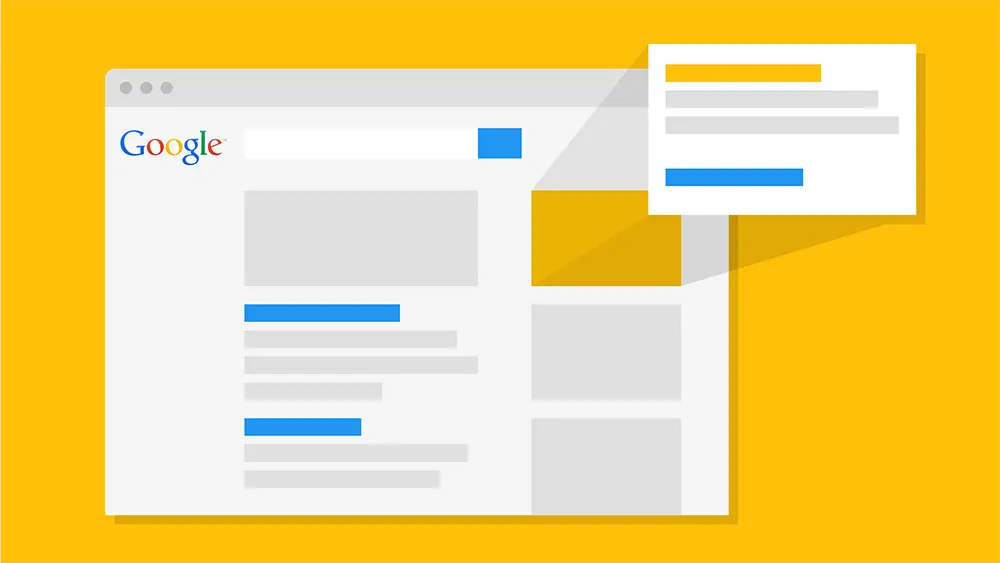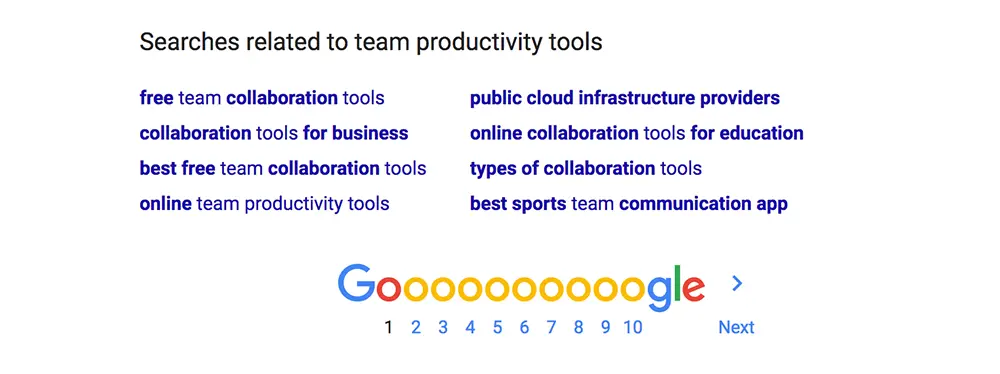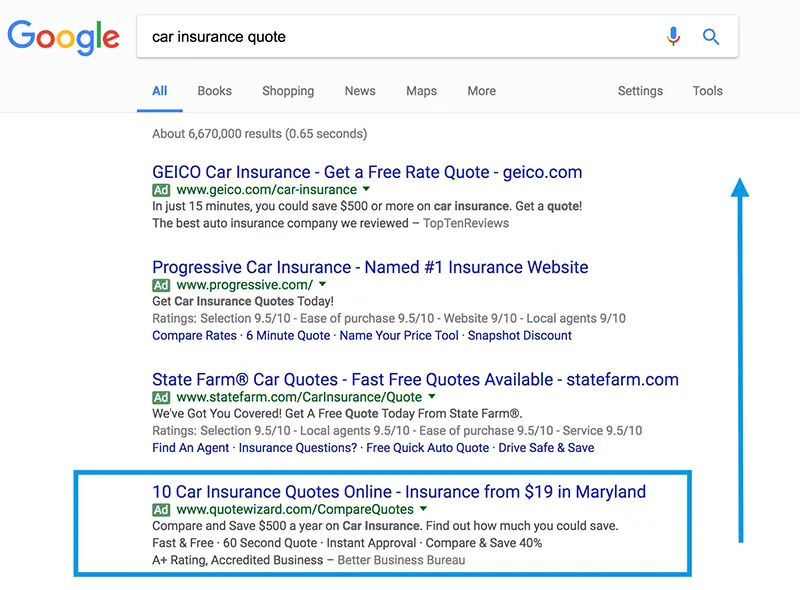Search advertising is a great way to get in front of your customers, generate leads, or test interest in new business ideas. Users show intent that they recognize there is a problem and may already be searching for a solution you can provide. This makes search advertising very powerful because you are able to get in front of users when they are making buying decisions.
This article builds on the concepts in An Introduction to Advertising for Lead Generation. If you aren’t familiar with things like cost-per-click, impressions, and calculating ROI, I recommend starting with that first.

Introduction
AdWords is an advertising platform built by Google that includes search, display, video, and app advertisements. You can use AdWords to show your advertisements on other websites within the Google display network, inside mobile applications, on search result pages, and more.
This article is going to focus on search advertising.
You can set up AdWords by creating an account, campaign, and finalizing your billing. We’ll focus on search advertising and take a closer look at campaigns and how the different components work together to put your message in front of potential customers.
Queries vs. Keywords
AdWords is a way for advertisers to choose keywords they want to advertise for. These keywords map to different search queries someone may be searching for. For example, you may want to advertise for a keyword such as team productivity and Google will do it’s best to display your advertisement to people looking for team productivity related queries.
The good news…
Every time a user does a search on Google, an algorithm is ran to determine which of your keywords are relevant to this query. If you haven’t noticed yet, this means that keywords don’t need to exactly match the query a user searches for. Coming back to the team productivity keyword, your ads could be eligible to display for a variety of search queries such as:
The bad news…
A normal keyword can match tons of search queries which you may or not expect. This can be an issue because you may only want your advertisement to display to those specifically searching for team-based tools. Or, you may be offering a paid solution and it would not be worthwhile to advertise to people searching for free options.
Fortunately, AdWords has a way to determine how strict the search query should match your keyword.
Keyword Match Types
The most basic and default match type is broad match. More times than not, you will get a lot of irrelevant impressions when using broad match. Let’s dive into each match type to see how strict they are and what potential search queries could trigger them to display:
Broad Match – Least Strict
When you use broad match, it means your keywords will be eligible for anything that “broadly” matches the original search query including synonyms and variations of the keywords you entered.
Keyword: team productivity tool
Potential Matching Queries: team productivity tool, self improvement productivity, productivity calendar, productivity tips, free productivity tool, how to focus at work, how to be more productive
It is rare that you will ever want to use broad match because you will display for a lot of queries which your ad may not be relevant for.
Modified Broad Match – More Strict
Modified broad match is a match type that allows you to choose specific words that are required to be in the search query.
For example, you may want to make sure that the query includes “productivity” and “tool”. The way to denote a keyword as modified broad match is to put a plus sign in front of the words that are required.
Keyword: team +productivity +tool
Potential Matching Queries: team productivity tool, productivity tool, personal productivity tool, productivity tool for personal use, free productivity tool, productivity tools free, tools to increase productivity
Queries you WON’T Match: free productivity app, productivity app for iphone, tools to improve focus, self improvement productivity, productivity tips
For the keyword team +productivity +tool, your ad will only be eligible for queries that include productivity and tool. With modified broad match, the required words DO NOT need to be in a specific order or next to each other.
Phrase Match – Second Most Strict
Phrase match is a bit more strict than modified broad match because it requires that the entire keyword is in the search query and in the correct order. You can mark your keyword as phrase match by wrapping it in quotations.
Keyword: “team productivity tool”
Potential Matching Queries: team productivity tool free, free team productivity tool, team productivity tool for iphone, android team productivity tool
Queries you WON’T Match: team productivity plugin, team productivity free tool, personal productivity tool, team tool for productivity, tool for team productivity
When using phrase match, the entire phrase must be in the order you specified and in the search query. It will still match for queries with words before or after your phrase.
Exact Match – Most Strict
Exact match is the most strict match type and means that the search query must match the keyword exactly. No synonyms, words before or after your keyword, and it must be in the correct order.
The way to designate a keyword as exact match is by wrapping it in brackets as shown here:
Keyword: [team productivity tool]
Potential Matching Queries: team productivity tool, team productivity tools
Queries you WON’T Match: team productivity tool iphone, free team productivity tool, team productivity browser plugin tool
Exact match requires an exact match. Your keyword is only eligible to display for the exact match or very slight variations such as pluralization and tense.
Negative Keyword
Negative keywords are keywords that tell AdWords explicitly which types of queries you do not want to display for. These can be set at the campaign or ad group level.
For example, if your tool costs money, you may not want to buy traffic for people searching for free tools. You can set free as a negative keyword to prevent matching for queries including free.
Keyword: -free
Potential Matching Queries: team productivity tool, team productivity tools
Queries You WON’T Match: free team productivity tool, team productivity tools for free
As you build your campaign you should continue to build your negative keyword list. Armed with the knowledge of which types of queries are not successful for your campaign, you can increase your campaigns effectiveness by explicitly defining poorly performing keywords as negative.

Carefully Pick and Choose Your Keywords
Now that you know the match types in Google AdWords you may be wondering when to use each type. How and when to use each type of keyword depends on your advertising goals and how strict you want to be.
When to be less strict
More times than not, you’ll want to use phrase match and exact match but there is still a place and time for broad match and modified broad match. You may consider using them if you are creating a new campaign and you want to test what types of queries people actually search for.
For example, if you are releasing a team productivity tool, you may want to do a broad match to see specifically what types of queries users search for. You could use that knowledge to shape your product or get ideas for what types of phrase match or exact match keywords you can use.
Another time you may want to use less strict match types is if your goal is brand awareness. In this case, you may not care as much about relevance because you just want people to become more aware of your brand.
When to be more strict
Being more strict allows you more control over what types of search queries your ads display for. You want to be more strict when you are scaling your advertising spend to ensure you are getting relevant traffic. The more strict your keywords are, the more relevant your ad and landing page copy can be.
Keyword Planning
Now that you know how search queries and keywords work together, you can start planning out the keywords you want to use for your campaign. AdWords Keyword Planner is a great tool for higher level research. You can estimate search volume for keywords and what your max CPC should be set to.
The keyword planner is very in-depth and is a great starting point when doing keyword research and planning. However, it isn’t perfect so you should always test your keywords and advertisements before fully jumping in.
When you are doing keyword research and planning for your campaign, there is no science or clear-cut solution. You’ll want to get keyword suggestions from the keyword planner or ask friends what they would search for if they were your potential customer.
Another good way to get suggestions for keywords is by doing a Google search for your primary keyword such as team productivity tool. At the bottom of the search results page you’ll typically see related searches:

You can use these related searches to get an idea for the other types of queries that users are searching for.
Ad Groups
An AdWords campaign is a collection of ad groups that should isolate different value propositions or parts of your website. An ad group consists of keywords and advertisements so it is important to make both of those consistent.
When someone searches on Google, AdWords does the normal matching algorithm to see if you have any keywords that match. If you do, one of the advertisements in that ad group is displayed to the user. It is crucial that the headline and description of your advertisement is relevant to the keywords that may trigger it to be displayed.
Given an ad group with one keyword, the exact match keyword [team productivity tool], you should create ads that speak to users who are searching for team productivity tools. The more relevant you can make your advertisements, the more likely a user will click-through to your landing page.
Writing Your First Ad
AdWords occasionally updates the formatting for how an advertisement appears in the search results so we’ll be covering this at a higher level. When you’re writing your ads, it’s important to try to connect to the person viewing it.
Going back to your sales 101 class, you want to sell the benefits of your product or service–not the technical features or specifications. A good advertisement connects on an emotional level by positioning the product or service to match the worldview of the person viewing it.
Strong Ad Copy
When writing your advertisement, you want to follow the same best practices you would use when writing copy for your landing page or other marketing assets. Talk about what makes you unique, how you can help your customer solve a problem, and the benefits of your solution.
Call To Action
Ask the people viewing your ad to perform an action. You can offer a promotion, free shipping for example, and have part of your ad say “Buy Now for Free Shipping.”
Be Relevant
Since Ad Groups match keywords with advertisements, it’s important to keep those organized and relevant. If you have a suite of products and one of your keywords is team productivity tool, you don’t want to have an advertisement in that ad group that talks about your human resources tool.
Ideally, you want the landing page you send users to and your ad copy to include your keyword and be highly relevant to that keyword.
Don’t be Spammy
You want your ads to read professionally. Don’t use ALL CAPS, don’t spam FREE, and don’t MiX CaSeS. Try to use common language and a simple writing style.

Examples of good advertisements
Take a look at Google’s article on writing successful ads for more tips.
Quality Score
Relevance is very important–both at the ad copy and landing page level. If you think about Google’s business, they earn money by moving users off of their website and on to yours. This can be risky because you could damage their user experience by providing a poor experience to a user who found you on Google.
If your website is offensive, not mobile friendly, or not relevant to what users are looking for, then they could blame Google for their poor experience.
Enter the Quality Score.
Quality Score is a metric that evaluates the quality of your advertisement, landing page, and keywords. It checks to make sure your landing page is relevant to the advertisement you are writing and the keywords you are advertising for. Google also looks at your historical click-through rates and compares that to industry averages.
If the average click through rate for your industry is 2% and yours is 4%, then Google will assume that your advertisement must be higher quality.
Quality Score is a scale of one to ten with ten being the highest. You may be thinking that “quality score sounds great…but if I’m getting traffic who cares if my score is high or low?” Google uses your advertisement’s relevance, estimated click through rate, and landing page experience as components for determining the order of advertisements on a search result page. It also affects the CPC price for your ad.
If your advertisements are low-quality, your landing page has a poor experience, or you have low-click through rates then you’ll be paying more for your traffic than your competitors who have done those things well–and your price could be substantially higher.
If Google is showing four ads for your keyword and you are showing up at the bottom, you would want to improve your position. You could achieve this by increasing your max CPC bid but you could also do this by improving the quality of your advertisement and landing page.

Moving Forward
Google AdWords is an excellent place to start if you are looking to advertise for lead generation. This article covered a lot of the basics of what an AdWords campaign looks like and how the different components work together.
Campaigns consist of many ad groups. Ad groups consist of keywords and advertisements. As an advertiser, your goal is to organize your campaigns, ad groups, keywords, and advertisements in a way that allows you to be relevant to the user and what they searched for.
As with all things advertising, it is important that you take a methodical approach to testing. You do not want to create a campaign with a large budget and call it a day. It’s much better to test your campaign on a limited budget, make optimizations, and scale your budget as you start to learn what is most successful.
Upcoming in this series will be articles on how to organize your campaigns, a closer look at quality score and ad rank, budgeting, and more.
In the meantime, your AdWords adventure has just began so here are some great links to learn more: